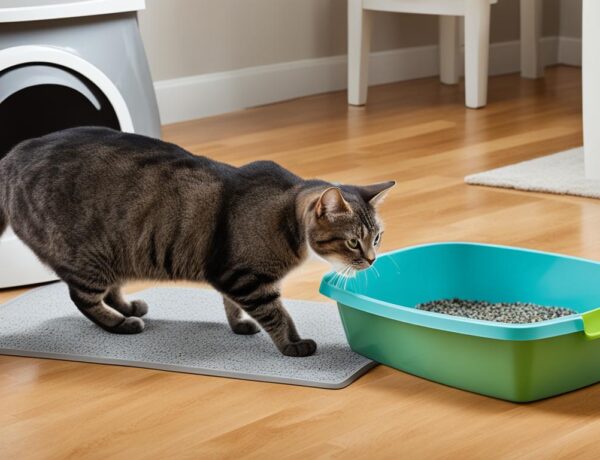Pet ownership is a deeply cherished bond between humans and their animal companions. As a pet owner myself, I understand the importance of effective communication in enhancing this special connection. Whether it’s conveying our love, teaching them new tricks, or ensuring their well-being, communication plays a vital role in every aspect of pet care.
In this article, we will explore various strategies that can help pet owners enhance their bonds with their furry friends, connect more effectively with veterinary professionals, and train their pets with success. From understanding the needs of pet parents to leveraging modern technology, we’ll cover it all to ensure that your communication skills with your pets and within the pet care community are top-notch.
Key Takeaways:
- Effective communication strengthens the bond between pet owners and animals.
- Understanding the needs of pet parents, particularly Millennials, is crucial.
- Compassion, empathy, and active listening foster trust and favorable relationships.
- Written instructions and informed consent improve compliance and patient outcomes.
- Targeted marketing strategies can enhance brand awareness and reach.
Understanding Your Clients and Their Needs
Millennials now represent the majority of pet owners, spending billions of dollars annually on their pets. They treat their pets as their own children and have high expectations for their care. Recognizing this unique relationship and tailoring your communication strategies to meet their needs can help build trust and strengthen relationships with pet owners.
With pet parent demographics shifting towards Millennials, it is crucial to understand their pet owner experience and cater to their needs. Millennials, born between 1981 and 1996, are known for being family-oriented and having a strong desire to provide the best for their furry companions.
According to a report by the American Pet Products Association, Millennials own more pets than any other generation. They are enthusiastic, passionate, and willing to invest in their pets’ well-being.
When engaging with Millennial pet parents, it is essential to acknowledge their personal connection with their pets. They consider their pets as part of the family and expect veterinary professionals to provide the same level of care and attention.
To effectively communicate with Millennials, it is crucial to consider their client needs. They value transparency, personalized experiences, and open communication. By understanding their expectations and tailoring your approach to meet these needs, you can establish a strong rapport with Millennial pet owners.
When interacting with Millennial pet parents, emphasize the importance of preventive care, address their concerns empathetically, and provide clear explanations of medical procedures. Additionally, incorporating technology into your communication strategy, such as offering online appointment booking or telemedicine services, can enhance convenience and accessibility for Millennial pet owners.
Millennial Pet Owner Demographics
To gain a deeper understanding of the pet parent demographics that define Millennials, let’s take a closer look at the numbers:
| Demographic | Statistics |
|---|---|
| Millennial Pet Ownership | Millennials represent the largest cohort of pet owners, comprising 35% of the total pet-owning population in the United States, according to the American Pet Products Association. |
| Pet Spending | Millennials spend an estimated $67 billion annually on their pets, according to a report by TD Ameritrade. |
| Family Orientation | Millennials prioritize their pets as family members. A survey conducted by Michelson Found Animals indicates that 80% of Millennials consider their pets as their “fur-babies.” |
| Technology Adoption | Millennials are tech-savvy and rely heavily on digital channels for information. According to a survey by Wakefield Research, 63% of Millennial pet owners use online resources to research pet-related topics. |
By aligning your communication strategies with the unique needs of Millennial pet owners, you can create a positive and enriching pet owner experience. Maintaining a family-oriented approach and adapting to their preferences and expectations will not only enhance client satisfaction but also foster long-lasting relationships with Millennial pet parents.
The Role of Compassion and Empathy
In the pet care industry, cultivating a positive relationship with pet owners is essential for effective communication and building trust. One of the most powerful ways to achieve this is by showing genuine compassion and empathy towards pet owners.
As a veterinarian, taking the time to address their concerns, provide reassurance, and answer questions can go a long way in alleviating their stress and anxiety. By demonstrating that you genuinely care about their pets’ well-being, you create a favourable environment for open and honest communication.
“The positive effect of compassion and empathy in veterinary care cannot be overstated. It allows pet owners to feel understood, valued, and supported, fostering a strong bond and a sense of trust between the veterinarian and the pet owner,” explains Dr. Jane Thompson, a renowned veterinary professional.
Showing compassion towards pet owners means acknowledging their emotions and concerns. By actively listening and validating their feelings, you create a safe space for them to express themselves and discuss their pet’s health without hesitation. Empathy, on the other hand, involves putting yourself in their shoes and understanding their perspective.
Empathy can be particularly effective in situations where pet owners may be facing difficult decisions or experiencing grief. By relating to their emotions and offering support, you can help them navigate these challenging moments with greater ease and understanding.
Moreover, when pet owners feel heard, understood, and supported, they are more likely to trust your expertise and follow your recommendations. This ultimately leads to better compliance and improved patient outcomes.
Empathy in Action: A Personalized Approach
Understanding the importance of compassion and empathy, Dr. Lisa Johnson, a veterinary professional with over 15 years of experience, shares her approach:
- Listen actively: When a pet owner expresses their concerns, make sure to give them your undivided attention. Maintain eye contact, nod to indicate understanding, and refrain from interrupting.
- Validate their emotions: Acknowledge their feelings and concerns. Use phrases like “I understand how worried you must be” or “It’s completely normal to feel anxious about your pet’s health.”
- Offer reassurance: Provide clear and concise explanations, addressing any potential risks and outlining the steps you will take to ensure the best care for their pet.
- Follow up: After the initial consultation, reach out to check on the pet and the pet owner. This simple gesture can go a long way in strengthening the relationship and showing ongoing support.
By incorporating compassion and empathy into your communication strategies, you can foster a positive and trusting relationship with pet owners, leading to improved client satisfaction and better overall outcomes.
Effective Listening and Reflective Communication
Effective communication goes beyond just speaking; it involves actively listening and understanding the needs of your clients. Reflective listening is a crucial skill that enables veterinarians to demonstrate empathy and ensure accurate comprehension of the information shared. By summarizing and repeating back what the client has said, you can confirm understanding and address any potential misunderstandings.
Reflective listening begins with actively engaging with the client during the conversation. Maintain eye contact, nodding, and providing verbal cues to show that you are attentive and focused on their needs. Once the client has finished speaking, take a moment to recap and rephrase the main points of their concerns or questions. This not only demonstrates your understanding but also reassures the client that their concerns have been heard and acknowledged.
“Reflective listening allows veterinarians to connect with clients on a deeper level, building trust and fostering effective communication.” – Dr. Samantha Adams, Veterinary Communication Specialist
Asking clients to reflect on the information they have received further confirms comprehension and helps address any potential misunderstandings. You can ask open-ended questions such as, “Based on what we’ve discussed, how do you plan to implement these recommendations?” or “Can you summarize what we’ve talked about today?”. Encouraging clients to reiterate the key points ensures that they have understood the information shared and are prepared to take the necessary steps.
Furthermore, evaluation of outcomes and setting realistic expectations with clients is vital for effective communication. This involves discussing the potential outcomes of different treatment options, including the risks and benefits. By involving clients in the decision-making process and providing them with a clear understanding of what to expect, you can ensure their needs are met, and the communication remains transparent.
Benefits of Reflective Listening and Recap
Through reflective listening and recap, veterinarians can:
- Enhance understanding between the veterinarian and the client
- Address misunderstandings and clarify information
- Build trust and rapport with clients
- Provide personalized care based on individual client needs
- Improve client satisfaction and loyalty
By incorporating these strategies into your communication approach, you can foster a positive client experience and strengthen the bond between pet owners and veterinary professionals.
| Reflective Listening Steps | Benefits |
|---|---|
| 1. Actively engage and maintain eye contact | – Demonstrates attentiveness – Shows respect and empathy |
| 2. Recap and rephrase the client’s main points | – Confirms understanding – Reassures the client that their concerns have been heard |
| 3. Encourage reflection through open-ended questions | – Ensures comprehension – Addresses potential misunderstandings |
| 4. Evaluate outcomes and set realistic expectations | – Provides transparency – Enhances client satisfaction |
Written Communication and Informed Consent
When it comes to providing top-notch care for our beloved pets, effective communication is key. One vital aspect of communication in veterinary practice is providing written instructions to pet owners. These written instructions not only include essential care recommendations but also provide monitoring instructions that can improve compliance and patient outcomes.
Informed consent is another crucial component of communication in veterinary practice. By ensuring that pet owners understand the potential risks and benefits of treatment options, we empower them to make informed decisions about their pets’ care. Informed consent allows pet owners to stay informed and involved, fostering a sense of trust between veterinary professionals and pet owners.
Written communication and informed consent go hand in hand to enhance both the pet owner’s and the pet’s overall care journey. When pet owners receive written instructions, they have a tangible resource to refer to when caring for their pets at home. This promotes better compliance with the recommended care plan, leading to improved patient outcomes.
“Providing written instructions to pet owners not only enhances compliance but also empowers them to feel more confident in caring for their pets.”
Enhancing Compliance and Patient Outcomes
Research has shown that written instructions significantly improve compliance with treatment plans. By having clear and concise instructions in writing, pet owners are more likely to follow the recommended care regimen. This translates into better patient outcomes, reducing the risk of complications and promoting faster recovery.
Furthermore, written instructions help pet owners feel more confident in providing care and handling potential emergencies. They serve as a valuable reference guide, ensuring that pet owners understand the necessary steps to take when maintaining their pet’s health.
Empowering Pet Owners through Informed Consent
Informed consent plays a vital role in building trust with pet owners. By openly discussing the potential risks, benefits, and alternatives to treatment options, veterinary professionals demonstrate their commitment to transparency and patient-centered care. Informed consent allows pet owners to actively participate in decision-making, fostering a collaborative approach to their pet’s healthcare.
When pet owners have a complete understanding of their pet’s treatment plan, they are more likely to adhere to it and actively engage in the care process. This creates a supportive environment where veterinary professionals and pet owners work together to achieve the best possible outcomes.
Additionally, informed consent helps pet owners feel reassured that they are making informed decisions about their pet’s well-being. It provides peace of mind in knowing that their veterinarian has thoroughly explained the treatment options and respects their pet’s best interests.
The Importance of Written Communication and Informed Consent
By combining written communication and informed consent, veterinary professionals empower pet owners to actively participate in their pets’ care. This not only enhances compliance but also strengthens the bond between pet owners and veterinary professionals, leading to improved patient outcomes and overall satisfaction.
Now, let’s take a closer look at how written communication and informed consent positively impact pet care in the following table:
| Benefits of Written Communication and Informed Consent |
|---|
| Promotes better compliance with treatment plans |
| Reduces the risk of complications and promotes faster recovery |
| Empowers pet owners to feel confident in caring for their pets |
| Builds trust and fosters a collaborative approach to pet healthcare |
| Provides reassurance and peace of mind for pet owners |
As you can see, written communication and informed consent have a significant impact on pet care, ultimately benefiting both pets and their owners. By implementing these practices, veterinary professionals can ensure that they are providing the highest level of care and support to their patients and their human companions.
Leveraging Marketing Strategies for Pet Care Brands
Pet care brands have a unique opportunity to connect with pet owners through effective marketing strategies. By understanding the target audience and implementing tailored marketing efforts, brands can increase brand awareness and credibility among pet owners.
“Collaborating with pet influencers, utilizing product placement, and leveraging positive reviews can be powerful tools in building brand awareness and establishing trust with pet owners.”
Identifying the target audience is the first step in developing an effective marketing strategy. By understanding the demographics, preferences, and motivations of pet owners, brands can create targeted campaigns that resonate with their audience. This includes considering factors such as pet type, age, and lifestyle to tailor marketing messages accordingly.
One effective strategy is collaborating with pet influencers who have a strong following and influence among pet owners. These influencers can promote products or services and provide endorsements that resonate with their audience. By partnering with influencers who align with the brand’s values and target audience, pet care brands can effectively reach and engage with their desired demographic.
Product placement is another valuable marketing tactic that can increase brand visibility. By strategically placing products in popular pet-related media, such as movies, TV shows, or online videos, brands can expose their products to a wide audience. This form of indirect advertising can create subconscious associations between the brand and positive experiences, leading to increased brand recognition and customer engagement.
Influencer Collaboration and Product Placement Examples
| Influencer | Platform | Product Placement |
|---|---|---|
| Marutaro the Shiba Inu | ||
| Gabe the Dog | YouTube | |
| Lil BUB |
Lastly, leveraging positive reviews can significantly impact brand awareness and trust among pet owners. Utilizing customer testimonials and reviews on websites, social media platforms, and other marketing materials can build credibility and encourage potential customers to choose your brand.
Implementing a comprehensive marketing strategy that incorporates influencer collaboration, product placement, and positive reviews can significantly enhance brand awareness and reach among pet owners. By effectively targeting the right audience and utilizing these strategies, pet care brands can establish a strong presence and foster long-term relationships with their target audience.
Conclusion
Effective communication strategies play a vital role in the pet care industry, allowing veterinary practices and pet care brands to build trust, enhance relationships, and fulfill the needs of pet owners. By understanding the unique needs of pet owners and utilizing compassion, empathy, and effective listening skills, veterinary practices can improve client satisfaction and patient outcomes. Whether it’s addressing their concerns, providing reassurance, or answering their questions, genuine care and understanding go a long way in establishing a favorable relationship with pet owners.
Additionally, incorporating technology into communication efforts is essential to staying connected with pet owners. Websites and active social media presence keep pet owners informed and give them a platform to engage with veterinary practices. Technology also allows for efficient appointment scheduling, reminder systems, and online resources, making pet care more accessible and convenient for pet owners.
Moreover, pet care brands can leverage marketing strategies to effectively reach and engage with their target audience. By identifying their target audience and tailoring marketing efforts accordingly, they can raise brand awareness and credibility among pet owners. Collaborating with pet influencers, utilizing product placement, and leveraging positive reviews are effective ways to engage pet owners and drive brand loyalty.
In conclusion, effective communication strategies and marketing efforts are essential in the pet care industry to fulfill the gap between pet owners and service providers. By understanding pet owners’ needs, utilizing empathy and technology, and implementing targeted marketing strategies, the pet care industry can better serve its clients and ensure the well-being of their beloved pets.
FAQ
What are some effective communication strategies for pet owners?
Effective communication strategies for pet owners include utilizing technology to enhance communication, such as maintaining an updated website and active social media presence. It is also important to understand the unique needs of pet owners, show compassion and empathy, and practice reflective listening.
Why is understanding your clients and their needs important in the pet care industry?
Understanding your clients, particularly the demographics such as Millennials who view their pets as part of the family, is crucial for effective communication. Recognizing their unique relationship with their pets and tailoring communication strategies to meet their needs can help build trust and enhance the client-veterinary relationship.
How does compassion and empathy contribute to effective communication?
Compassion and empathy play a significant role in cultivating a positive relationship with pet owners. Showing genuine care, addressing their concerns, and providing reassurance can alleviate their stress and build trust, making pet owners more likely to trust your expertise and follow your recommendations.
What is reflective listening and why is it important in communication with clients?
Reflective listening is a communication skill that involves summarizing and repeating back what the client has said to ensure understanding. It helps to confirm comprehension, address any misunderstandings, and ensure the client’s needs are being met. Reflective communication fosters effective communication and strengthens the client-veterinary relationship.
How can written communication and informed consent improve client compliance and patient outcomes?
Providing written instructions, including essential care recommendations and monitoring instructions, can improve client compliance and patient outcomes. Informed consent ensures that pet owners understand the potential risks and benefits of treatment options, allowing them to stay informed and involved in their pets’ care.
How can marketing strategies be leveraged to reach and engage pet owners?
Pet care brands can effectively reach and engage pet owners by identifying their target audience and tailoring marketing efforts accordingly. Collaborating with pet influencers, utilizing product placement, and leveraging positive reviews can help build brand awareness and credibility among pet owners.






No Comments